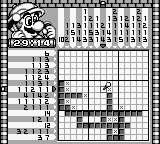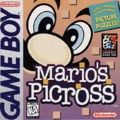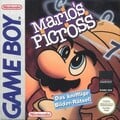Mario's Picross: Difference between revisions
m (→Legacy) |
mNo edit summary |
||
| Line 79: | Line 79: | ||
<br clear=all> | <br clear=all> | ||
{{GB}} | {{GB}} | ||
{{VirtualConsole}} | |||
[[Category:Mario Games]] | [[Category:Mario Games]] | ||
[[Category:Game Boy Games]] | [[Category:Game Boy Games]] | ||
[[Category:Puzzle Games]] | [[Category:Puzzle Games]] | ||
[[Category:1995 games]] | [[Category:1995 games]] | ||
Revision as of 12:17, July 18, 2011
Template:Articleabout Template:Infobox
Mario's Picross is a puzzle game for the Game Boy developed by Jupiter and the first game in the Nintendo-published Picross series. It was released in 1995 and stars Mario who appears in the role of an archaeologist. Mario's Picross is based on paint by number puzzles known as nonograms. Several sequels have been released since then. Most of them are Japan-only games.
Gameplay
The objective of each logic puzzle is to reveal a hidden picture in a grid by scraping specific squares of it. Each puzzle starts with an empty grid and several numbers are given at the side of each horizontal row and vertical column of the grid. The numbers tell the player how many squares have to be scraped in each line. The revealed pictures show food, animals and other objects, but also make some Mario series references.
For example, a "5" means that the player has to scrape five consecutive squares in the respective line. If there is more than one number, then there has to be at least one blank square between the scraped areas. For instance, "4 6 2" means that four consecutive squares have to be scraped in the line, followed by at least one blank square. After the blank space(s), the player has to scrape an area of six squares. Again, there has to be at least one blank square between this area and the last two consecutive squares that have to be scraped. If the player is sure that a square doesn't have to be scraped, e.g. when a blank square is needed or all required squares in a line have been scraped, he or she can mark it with an "X". Finally, the player will be able to reveal the hidden picture by logic thinking.
Modes
The game features 256 puzzles in total. All puzzles are a size of 15x15 squares, except for the 5x5 and 10x10 square puzzles of Easy Picross that are aimed at beginners. The puzzles are split into different modes:
- Easy Picross (64 puzzles for beginners)
- Picross (split into two courses)
- Kinoko Course (64 puzzles)
- Star Course (64 puzzles, unlocked after completing Kinoko Course)
- Time Trial (64 puzzles, unlocked after completing Star Course)
The first two modes, where the puzzles can be played in any order, follow the same rules. Before playing the game, the player can decide to get a hint, which means that the correct squares of a row and a column are already scraped when starting the puzzle. A roulette the player has to stop defines which lines are revealed to make the puzzle a bit easier accessible. Each puzzle is played against the time. The player has 30 minutes, but if a wrong square is scraped, the remaining time will be reduced. The first mistake will cost two minutes, the second one four minutes and all further mistakes will cost eight minutes each. When the time runs out before the player has revealed the picture, the game is over. For each puzzle, the best time will be saved.
The last mode known as Time Trial comes with different rules. The player does not get a hint at the beginning and there is no time limit. The game does not note wrongly scraped squares, so the player does not know whether a mistake has been made. The 64 puzzles appear randomly, the player is not able to select a specific puzzle. When the player has finished, he or she will learn if the correct squares have been scraped.
Cameos
Some of the pictures show characters, enemies and items from the Mario series. A picture of the Game Boy appears, too.
Easy Picross
- 6C - Boo Diddley
- 6H - Mario
Kinoko Cup
- 1A - Game Boy
- 1B - Star
- 3D - Bullet Bill
- 3G - Grand Goomba
Star Cup
- 2E - Mini Yoshi
- 4G - Spiny
- 5F - Mushroom
Time Trial
Reception
Mario's Picross was unable to sell notably well in both North America and Europe when it was released, leading both territories to no longer receive any more Picross games by Nintendo until Picross DS in 2007. The game, despite citations that the Game Boy's tiny screen makes it difficult to see the puzzles clearly, is considered a cult hit in the Western world.
Legacy
The western release was unsuccessful, and so Mario's Picross was the only Picross title released in the West for a long time. However, several sequels have been released in Japan due to the success in this region. The first one was Mario's Super Picross for the Super Famicom in 1995, followed by the Game Boy title Picross 2 in 1996. In 1999 and 2000, eight Picross NP games for the Super Famicom were released and could be downloaded by the players onto Nintendo Power cartridges. Four of them feature puzzles related to the Mario series.
After a very long gap, the 2007 game Picross DS was the second title in the series that was internationally released. However, the only references to the Mario series in this game are cameos. Mario's Super Picross was finally released in Europe and Australia for the Virtual Console in September 2007. In Japan, it came out in December 2006.
Gallery
- Mario's Picross JAP cover.jpg
Japanese box art (front)
External links
- Official Site from Nintendo (Japanese)
- Official Site from Jupiter (English/Japanese)
| Game Boy games | |
|---|---|
| Super Mario franchise | Alleyway (1989) • Baseball (1989) • Super Mario Land (1989) • Golf (1989) • Dr. Mario (1990) • Super Mario Land 2: 6 Golden Coins (1992) • Donkey Kong (1994) • Mario's Picross (1995) • Picross 2 (1996) |
| Donkey Kong franchise | Donkey Kong (1994) • Donkey Kong Land (1995) • Donkey Kong Land 2 (1996) • Donkey Kong Land III (1997) |
| Yoshi franchise | Yoshi (1991) • Yoshi's Cookie (1992) • Tetris Attack (1996) |
| Wario franchise | Wario Land: Super Mario Land 3 (1994) • Wario Blast: Featuring Bomberman! (1994) • Wario Land II (1998) |
| Miscellaneous | Tetris (1989) • The Legend of Zelda: Link's Awakening (1993) • Game & Watch Gallery (1997) • Game & Watch Gallery 2 (1997) |



